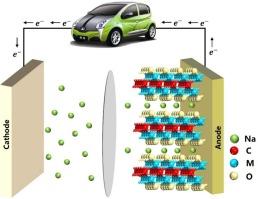Two-dimensional NbMCO2 (M = Ge, Sn, Sb and Bi) monolayers as a novel anode material for sodium-ion batteries by simulation insight
IF 6.9
2区 材料科学
Q2 CHEMISTRY, PHYSICAL
引用次数: 0
Abstract
The development of novel anode materials is of paramount importance for next-generation rechargeable metal-ion batteries. In this contribution, the potential of Nb2CO2 and NbMCO2 (M = Ge, Sn, Sb and Bi) monolayers as electrode materials for sodium-ion batteries is investigated upon the basis of first-principles within the framework of density functional theory. The five monolayers exhibit cohesive energies of 1.922, 0.935, 0.983, 0.910, and 1.051 eV/atom, suggesting that they are all energetically stable. Simultaneously, ELF analysis combined with AIMD simulations further confirmed that the five monolayers are structurally stable. It is found that except for the Sb-C terminal, the adsorption energy of other structures at each terminal TC site is more stable than that at other sites. Upon adsorption of Na atoms, the characteristics are modified from semiconductors to metallic, denoting a significant enhancement of the electrical conductivity. Notably, the most favorable diffusion barriers for NbGeCO2, NbSnCO2, NbSbCO2 and NbBiCO2 monolayers at the M–C (Nb–C) termination are 0.376 eV (2.210 eV), 0.269 eV (0.443 eV), 0.518 eV (0.463 eV) and 0.246 eV (0.483 eV), respectively. Interestingly, the M–C terminals in the NbSnCO2 and NbBiCO2 monolayers have relatively lower migration barriers than the Nb2CO2 surfaces, implying that the incorporation of Sn and Bi makes the migration more favorable and helps to promote fast charge/discharge capability. These results demonstrate that the NbMCO2 monolayers can provide potential applications as an anode material for sodium-ion batteries.

二维NbMCO2 (M = Ge, Sn, Sb和Bi)单层膜作为钠离子电池的新型负极材料
新型负极材料的开发对下一代可充电金属离子电池至关重要。本文在密度泛函理论框架下,基于第一性原理研究了Nb2CO2和NbMCO2 (M = Ge, Sn, Sb和Bi)单层作为钠离子电池电极材料的潜力。这5种单层膜的内聚能分别为1.922、0.935、0.983、0.910和1.051 eV/atom,表明它们都是能量稳定的。同时,ELF分析结合AIMD模拟进一步证实了五种单层膜的结构稳定。结果发现,除Sb-C端外,其他结构在各末端TC位点的吸附能均较其他位点稳定。吸附Na原子后,其性质由半导体转变为金属,电导率显著提高。值得注意的是,NbGeCO2、NbSnCO2、NbSbCO2和NbBiCO2单层膜在M-C (Nb-C)端最有利的扩散势垒分别为0.376 eV(2.210 eV)、0.269 eV(0.443 eV)、0.518 eV(0.463 eV)和0.246 eV(0.483 eV)。有趣的是,与Nb2CO2表面相比,NbSnCO2和NbBiCO2单层中的M-C端具有相对较低的迁移障碍,这意味着Sn和Bi的加入使迁移更有利,有助于提高快速充放电能力。这些结果表明,NbMCO2单层膜作为钠离子电池的负极材料具有潜在的应用前景。
本文章由计算机程序翻译,如有差异,请以英文原文为准。
求助全文
约1分钟内获得全文
求助全文
来源期刊

Applied Surface Science
工程技术-材料科学:膜
CiteScore
12.50
自引率
7.50%
发文量
3393
审稿时长
67 days
期刊介绍:
Applied Surface Science covers topics contributing to a better understanding of surfaces, interfaces, nanostructures and their applications. The journal is concerned with scientific research on the atomic and molecular level of material properties determined with specific surface analytical techniques and/or computational methods, as well as the processing of such structures.
 求助内容:
求助内容: 应助结果提醒方式:
应助结果提醒方式:


